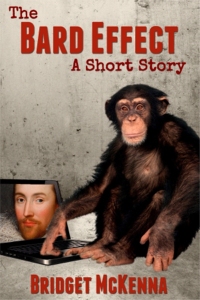 It's all in your point of view
It's all in your point of view You don’t need a Kindle to read Kindle books—you can read ’em on your computer, tablet, or phone. Meanwhile, help yourself to a free Self-Editing Quick Reference, in .doc or .PDF.
Shout-out to the Science Fiction Writers' Workshop of the University of Kansas James Gunn Center for the study of Science Fiction. Thanks for linking to the Self-Editing for Everyone series.
Now back to our regularly-scheduled program.
 One mind, one pair of eyes, one viewpoint
One mind, one pair of eyes, one viewpoint Like the director of a film, an author uses viewpoint to direct the reader’s attention. Viewpoint is how the reader experiences your story through the senses and thoughts of another person. When done well, it’s pretty nearly invisible.
It’s not within the scope of this article to discuss the myriad aspects of viewpoint in detail, but rather to discuss the ways in which you can recognize and fix those places where your handling of Point of View (POV) may have gone off the tracks.
Note:
My advice here is aimed at writers who like to write from a particular point of view and stay there until they switch to another, usually at a scene or chapter break. I realize that there are writers who like to switch from one viewpoint to another all through a scene or chapter, but most writing advice, including mine, recommends otherwise.
I’m of the school of writing that prefers to stay in one point of view until the reader needs information or insights that must come from another, then make the transition only at a clear break in the narrative, such as the end of a chapter. In my opinion this enables the reader to more closely identify with each character, and to know more of his goals and inner tensions. Each point of view also drives the narrative voice, and switching from one to another within a scene, in my opinion, dilutes the impact of that voice.
 Each POV a worldview, each worldview a universe
Each POV a worldview, each worldview a universe Every fictional viewpoint is also a worldview. That’s one reason it’s wise, in my opinion, to remain in one character’s POV for the length of a chapter or at least a scene that’s clearly marked with a visible scene break from the next. This allows the reader to feel anchored in that character’s story, and avoids confusion between viewpoints.
Here’s an exchange which switches POV between one paragraph and the next.
Cody had his doubts about Mina’s intentions. “Are you sure? You’re not going to change your mind later?”
“Of course I’m not, dummy.” Mina said. She worried about that boy. Was he going to cause trouble?
“Just stay where I can see you,” Cody told her. He couldn’t risk letting her out of his sight.
“Aye-aye, Cap’n. I’ll go first.” There was a passageway up ahead where she was pretty sure she could lose him.
I don’t know about you, but I feel like a spectator at a tennis match. I’m not at all sure whose story I’m in. If the author remained in one viewpoint until the other was needed, I’d be able to identify more closely with the worldview of one character. And the author would be able to conceal the thoughts and motives of the non-viewpoint character a lot more effectively, because if Mina intends to ditch Cody and the author doesn’t reveal that while in her POV, the reader is going to feel more than a bit cheated. If the author does reveal it, as above, it cheats the reader of a great deal of suspense.
While you’re writing in a particular character’s POV, the reader experiences everything the character does, and nothing the character does not. When you’re not in a character’s POV, you can observe that character’s actions and hear his speech, but have no idea what he’s thinking, seeing, hearing, or feeling.
“What can you tell me about Esparza,” I asked Frank.
“Esparza?” he said, puzzled. “I don’t know anyone named Esparza.”
Since we’re not in Frank’s POV in the example above, the reader can’t know if Frank is puzzled. Fortunately, the writer has made puzzlement clear in Frank's speech, making the blatant mind-read unnecessary.
 Give 'em an experience.
Give 'em an experience. While you’re in a particular character’s POV, the character—and by extension the reader—can’t know what any other character sees, hears, or feels. Be consistent in this. If the POV character doesn't experience something, the reader doesn't either. If the character doesn’t have knowledge yet, the reader can’t have that knowledge.
When in a character’s viewpoint, the writer can conceal what the character experiences only in limited ways. Keeping secrets in a third-person point of view is usually considered to be deceiving the reader, but it’s possible to conceal things in a first-person point of view by not reporting every detail when it happens and allowing the unreported detail to come out later.
I knew a lot more when I hung up the phone than I had before I called.
-
The bartender told me what I needed to know. I left a generous tip.
As I've repeated often throughout this self-editing series, let direct sensory experience be your guide. Let your reader directly experience what your POV character does. Don’t tell them. And let them experience what the character is experiencing, not what they’re trying or failing to experience.
Seeing from Outside
Sometimes you may begin a story from no-one’s point of view, rather like an establishing shot in a film. Fairly quickly, however, you’ll focus in on your point-of-view character and stay there. There are other times you might find stylistic reasons to use this approach, and during those times you’re in an unknown narrator’s point of view, you’re seeing your POV character from the outside. If this happens while a character is being introduced, before you reveal their name, you may even use terms like “the young man,” “the surgeon,” “the dark-haired woman.”
Now listen carefully: those are the only times you should view a POV character from the outside, or refer to her in terms that she would not use for herself, though someone else might. Once you know your hero’s name is Lance, for as long as you’re in Lance’s point of view, looking at the world from inside his head, do not refer to him as “the young man,” “the tall man,” “the magician,” or “the cowpoke.” Why? Because those kinds of tags are in an outside point of view, and when you step outside Lance to refer to him, you’re leaving his point of view for one that doesn’t actually exist, and you're throwing the reader out of the reading experience, which is something you very much do not want to do.
Keep your point of view consistent and logical. Your reward will be coherent narration and increased dramatic tension and reader immersion.
TL;DR
Anchor your reader in the story by getting inside one character’s head and staying there until you need information or insight from another character’s viewpoint.
Change viewpoint at clearly marked chapter-or-scene breaks to avoid reader confusion.
The reader can only experience what the viewpoint character does, and nothing the viewpoint character does not.
All the fabulous pulp magazine covers on this article series were created using the amazing Pulp-O-Mizer from art by its creator, Bradley W. Schenck.
Be sure to read the earlier Self-Editing for Everyone articles.
Part 1: The Most-Hated Writing Advice Ever
Part 2: Vampire Verbs, Zombie Verbs, and Verbs that Kick Ass
Part 3: Attack of the Adverbs!
Part 4: The Weakeners
Part 5: When Words Get in the Way
Part 6: Secrets of Relative Velocity
Part 7: Two Languages
Part 8: Dialogue Tags
Part 9: Dangling Modifiers
Part 10: Passive Voice
Part 11: Homophones

Thanks for linking to this blog post!
Reagan Wolfrom's Speculative Fiction Writing Wroundup
Did I miss anyone? Let me know!













 RSS Feed
RSS Feed




